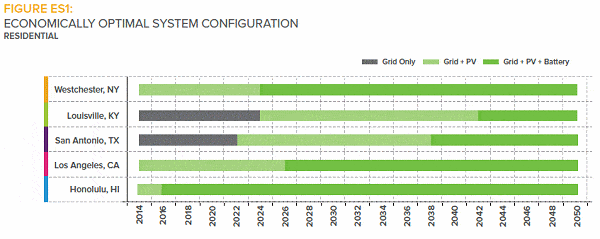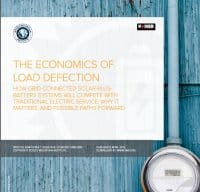A new report released by Rocky Mountain Institute (RMI) says solar-plus-battery systems will be the most economic residential electricity solution in three of the five US regions studied within the next 10–15 years.
In its report last year, Economics Of Grid Defection, RMI predicted solar and energy storage grid parity will likely arrive before 2030 and potentially as early as 2020 for millions of electricity customers. However, since that time new price points for solar power systems and storage have emerged that are proving less expensive than the averaged forecast.
The new report, Economics Of Load Defection, takes into account the new state of play and the implications for traditional utilities is significant. Compared to the off-grid systems analyzed in last year’s report, these new optimally sized, grid-connected solar-plus-battery systems will be able to hit economic parity sooner and across a wider swathe of the regions studied.
The report says as early as 2020, customer load defection could really start eating into utility annual energy sales in north-east USA – as much as ~10–20%. By 2030, load defection could jump to ~50–60%. By 2050, maximum possible load defection could impact most utility annual energy sales; ~80–97%.

For utilities considering increasing fixed charges as a way to grab back lost revenue, RMI has this warning:
“..residential fixed charges would likely alter (i.e., delay) the economics for grid-connected solar and solar-plus battery systems, but likely wouldn’t alter the ultimate load defection outcome. Customers might instead wait until economics and other factors reach a tipping point threshold and more dramatically “jump” from grid dependence to off-grid solar-plus-battery systems that offer better economics for electric service.”
It’s not all gloom and doom for utilities if they embrace this next revolution more rapidly and more warmly than they did the first (the initial rooftop revolution). The report says these grid connected solar + storage systems can “lower costs for distribution grid operators, providing values laterally to other customers on the distribution grid, and reducing high costs associated with peak load.”
But the incumbents don’t have a great deal of time to get ready to ride the next wave – and if the wave is approached incorrectly, it will end in a wipeout.
The 71-page Economics Of Load Defection can be downloaded here (free registration).












































